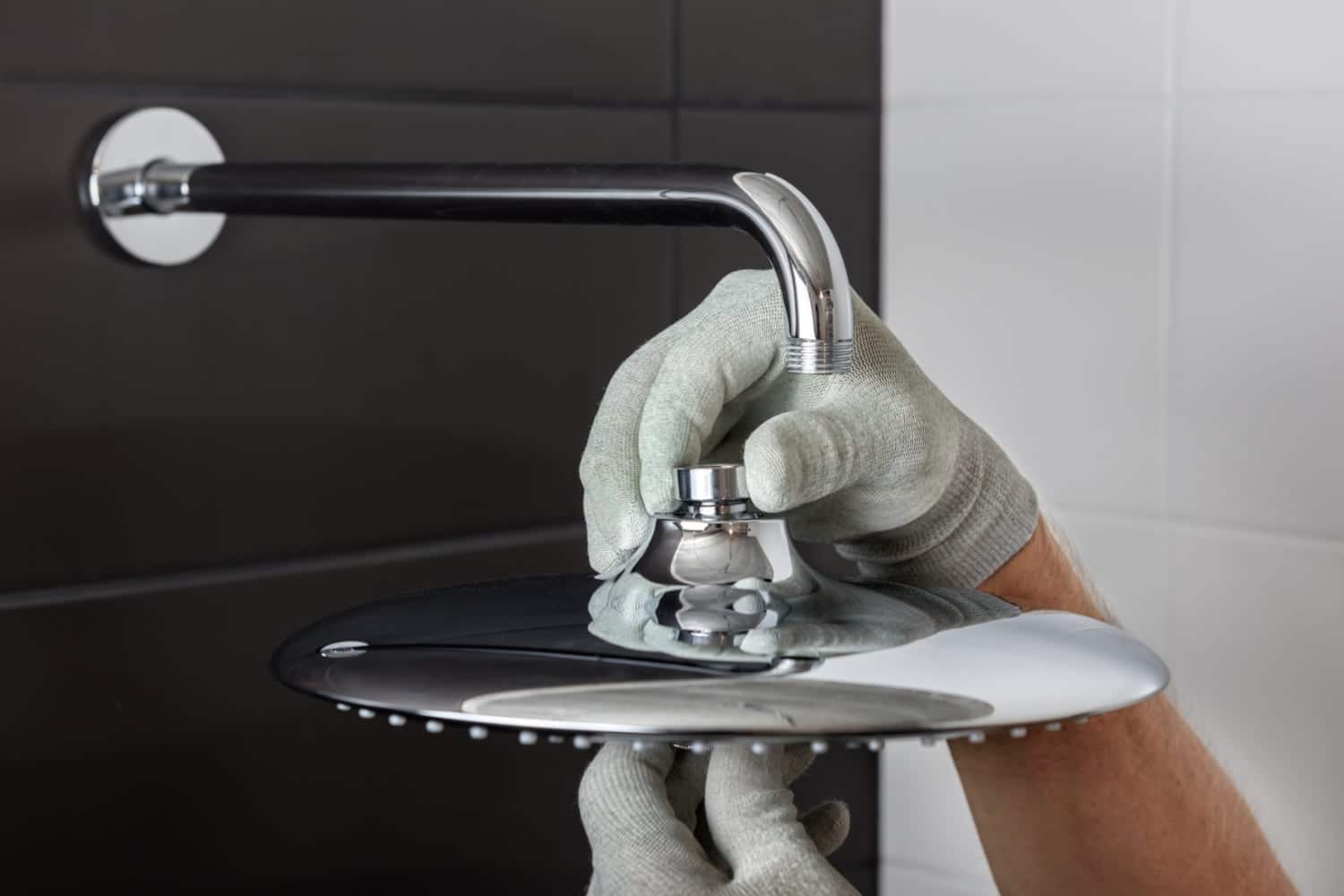Rainfall shower heads provide a spa-like appearance to any bathroom.
However, are they right for yours?
This article will focus on the benefits and drawbacks of rainfall shower heads, providing information to help you determine if one is right for your bathroom.
What is a Rainfall Shower Head?
A rainfall shower head is a large, circular or rectangular shower head that is mounted to the ceiling of your bathroom or is attached to an extended shower arm. It is designed to simulate the feeling of being outside in the rain, with a wide, gentle cascade of water.
Rainfall Shower Head vs. Regular Shower Head
Here’s a table that outlines the differences between a rainfall shower head and a regular shower head:
| Rain Shower Heads | Traditional Shower Heads | |
|---|---|---|
| Cost | Typically cost between $100 – $300 | Typically cost under $100 |
| Flow Rate | Usually > 2.0 GPM | 1.5 to 2.5 GPM |
| Installation | Professional strongly recommended | DIY |
| Spray Options | Limited | Several |
| Water Pressure | Moderate | Low to high |
| Space Requirements | Large bathroom | Small to large bathroom |
To further compare these two types of shower heads, we recommend you read this post, where we expand on all the key points above.
The Cons of Rainfall Shower Heads that You Should Know

Here are a few downsides of rainfall shower heads that you should be aware of before making a purchase.
- Ceiling Mount Limits Functionality: Mounted to the ceiling of your bathroom, it mimics the feeling of a gentle rain shower. While initially, this may be nice, it has some notable drawbacks. In particular, when cleaning your body, rainfall shower heads make it difficult to thoroughly rinse the lower half of your body, as you cannot angle the shower head to a more comfortable position.
- Limited Spray Patterns: Most rainfall shower heads only have one spray pattern – rain. The lack of other settings, including massage, jet, or spray, is understandably frustrating for some, as you cannot change the water flow or pressure to suit your needs. For example, if you prefer a misty or aerated spray and your partner likes a stronger jet spray, you will find it difficult to get the spray pattern you both desire.
- Space Requirements: With a head diameter measuring between 6 to 12 inches on most models, many smaller homes may need more space to install this type of shower head as a standard bathtub or shower may not be large enough to accommodate it.
- Varying Height: When installing a rainfall shower head, the height of all family members using it must be considered. Should you have shorter ceilings, a taller individual may have some issues showering comfortably.
- Head Diameter: If the diameter on the shower head skews smaller, most of the water will hit you on the head and not the body. Leaving the rest of your body, especially if you carry a larger frame, feeling cold.
- Water Pressure: A complaint many clients is that rainfall shower heads have less water pressure than a traditional shower head. Despite having a higher flow rate, typically between 2 and 2.5 GPM, the larger shower head disperses the water over a larger area, resulting in lower overall pressure. When you take this into account, along with the limited spray patterns mentioned previously, it can be quite frustrating.
- Maintenance: Just like a standard shower head, you will still need to clean this shower head regularly to prevent any buildup of mineral deposits. In addition, you may need to use a ladder to reach the head to do this properly, as installing and uninstalling the unit isn’t as easy.
- Professional Installation: Depending on the mount, an additional water line may need to be run above the ceiling by a professional plumber to install the shower head. This carries a higher initial cost and also limits your ability to revert back to a more traditional shower head in the future if you decide you don’t like it. With that being said, this also limits the use only to homes that you own; renters will need to get permission from their landlord to install this type of shower head – which they likely will not grant.
- Environmental Impact: With a higher flow rate and likely a higher amount of time needing to bathe when compared to a typical shower head, rainfall shower heads use significantly more water than a standard shower head. This can be a concern for those who are environmentally conscious or live in an area with limited water supply. Additionally, the increase use of water can also increase your water bill.
- Mobility Concerns: Older folks or those with limited mobility won’t be able to thoroughly clean while standing or sitting in the shower as there is no handheld option. This limits their ability to bathe independently, which can be a concern for many.
The Pros of Adding a Rainfall Shower Head to Your Bathroom

Despite the notable drawbacks, there are some reasons that you may want to consider adding a rainfall shower head to your bathroom.
- Spa-Like Appearance: There is no denying that rainfall shower heads look nice and provide a relaxing experience. If you are looking to give your bathroom a more luxurious feel, this shower head will certainly help.
- Bathing for Couples: Looking to spice things up in the bathroom? Then a large overhead shower head at least 12″ in diameter may be just what you need. Due to the increased space, a couple can easily bathe together, scrub one another, and even have some fun.
- Wellness Benefits: From hydrotherapy to muscle relaxation, showering under the steady stream of a rainfall does good for both the body and mind. That’s because the warm water cascading down your body helps reduce stress and tension and improve circulation.
- No Adjustments Necessary: With a fixed point of water flow, you never need to re-angle the shower head after your partner or a family member has used it.
What Customers Thought of Rainfall Shower Heads After Using Them
Aside from our own list of pros and cons, we also did some research to see what customers thought of rainfall shower heads after using them. In general, most were not happy with this shower head type. The most common complaints were around the constant stream on their hair and not the rest of their body (notably when washing armpits and waist area), the lack of water pressure, and the lack of spray patterns.
In fact, some home owners ended up installing a secondary shower head with a diverter valve to get the best of both worlds. This allowed them to switch between the rainfall shower head and a standard shower head when needed.
Can You Install a Rainfall Shower Head Yourself?
If you are comfortable with plumbing fixtures and have the right tools, you may be able to install a rainfall shower head via an extended shower arm. All this requires is shutting off the water supply, disconnecting the old shower arm, and connecting the new one. If you are installing a ceiling-mounted model, you may need a professional to install the plumbing as you will need to run a water line through the ceiling and line it up perfectly.
Here’s a helpful video on how to install a rainfall shower head for both an extended shower arm and ceiling-mounted model:
And here’s another video demonstrating how to install a ceiling shower head in an existing bathroom:
